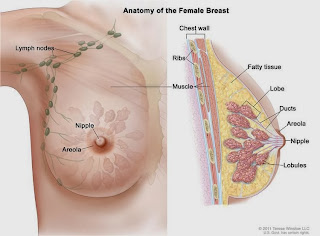Breast Cancer
What Are the Symptoms of Breast
Cancer?
*In its early stages, breast cancer usually has no symptoms. As a tumor develops, you may note the following signs:
*A lump in the breast or underarm that
persists after your menstrual cycle. This is
often the first apparent symptom of breast
cancer. Lumps associated with breast
cancer are usually painless, although some
may cause a prickly sensation. Lumps are
usually visible on a mammogram long
before they can be seen or felt.
*Swelling in the armpit.
*Pain or tenderness in the breast. Although
lumps are usually painless, pain or
tenderness can be a sign of breast cancer.
*A noticeable flattening or indentation on the breast, which may indicate a tumor that
cannot be seen or felt.
*Any change in the size, contour, texture, or
temperature of the breast. A reddish, pitted
surface like the skin of an orange could be
a sign of advanced breast cancer.
*A change in the nipple, such as a nipple
retraction, dimpling, itching, a burning
sensation, or ulceration. A scaly rash of the
nipple is symptomatic of Paget's disease,
which may be associated with an underlying
breast cancer.
*Unusual discharge from the nipple that may be clear, bloody, or another color. It's
usually caused by benign conditions but
could be due to cancer in some cases.
*A marble-like area under the skin.
*An area that is distinctly different from any
other area on either breast.
Breast Cancer: Treatment by Stage
Stage 0 Breast Cancer Treatment
Options
*Stage 0 breast cancer is early stage cancer.
*
In Stage 1 breast cancer, the cancer is still
considered in an early stage. Learn about its
treatment options.
*
In stage 2 breast cancer, the cancer is in the
breast and may also be in nearby lymph nodes
*
In stage 3 breast cancer, cancer hasn't
spread far beyond the breast and nearby
lymph nodes
*Breast Self-Examination
A breast self-examination (BSE) involves
checking your breasts to help detect breast
problems or changes. Many breast problems
are first discovered by women themselves,
often by accident. Breast lumps can be
noncancerous (benign) or cancerous
(malignant). Breast cancer can occur at any
age, though it is most common in women
older than 50.
Many experts believe that the harms of
breast self-examination outweigh the
benefits. Others consider BSE an option for
women. Talk with your doctor about breast
self-examination.
A breast self-examination involves checking
your breasts for lumps or changes while
standing and lying in different positions and
while looking at your breasts in a mirror to
note any changes in their appearance. Once
you know what your breasts normally look
and feel like, any new lump or change in
appearance should be evaluated by a doctor.
Most breast problems or changes are not
because of cancer.
If you choose to do breast self-examinations,
this should not replace regular clinical breast
examinations (CBE) by a doctor and
mammograms. Breast implants do not
decrease a woman's risk for breast cancer,
so women with breast implants need to talk
with their doctors about performing breast
self-examinations.
*Why It Is Done
A breast self-examination is done to detect
breast problems, such as a lump or change in appearance, that may indicate breast cancer or other breast conditions that may require medical attention (such as mastitis or a fibroadenoma).
*How To Prepare
No special preparation is needed before
having this test.
Sent from my BlackBerry® smartphone, powered by Easyblaze




Comments
Post a Comment
Publish post